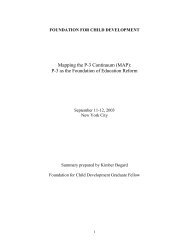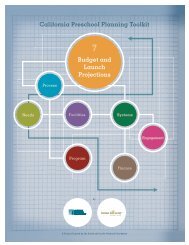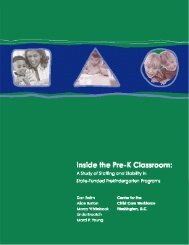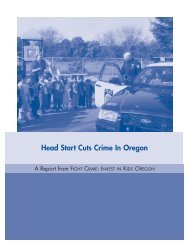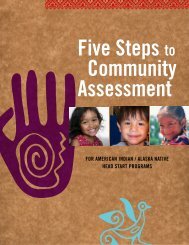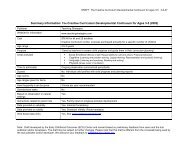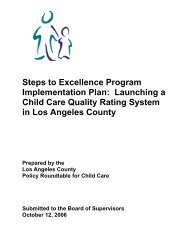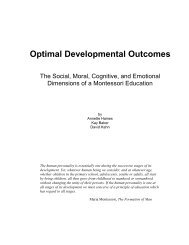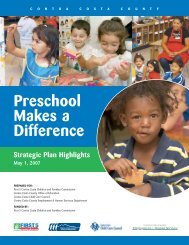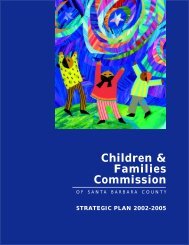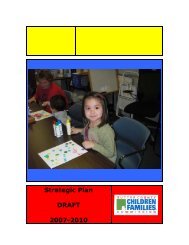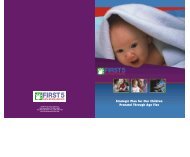Download this file - Plan4Preschool
Download this file - Plan4Preschool
Download this file - Plan4Preschool
Create successful ePaper yourself
Turn your PDF publications into a flip-book with our unique Google optimized e-Paper software.
schools, juvenile court schools, select alternative schools of choice that meet stringent<br />
SBE requirements, and Division of Juvenile Justice (formerly California Youth Authority)<br />
education programs.<br />
With the enactment of Assembly Bill 1295 (Chapter 887, Statutes of 2001), the Small<br />
Schools Model became part of the main statewide accountability system. In January<br />
2001, schools in <strong>this</strong> model began receiving Academic Performance Index (API) reports<br />
with an asterisk to designate the larger statistical uncertainty of an API based on fewer<br />
than 100 valid test scores. The 2002-03 API growth report includes these schools in the<br />
main API system.<br />
Schools in the Special Education Schools and Centers Model have been held<br />
accountable through the individualized education program (IEP) and quality assurance<br />
process. The California Alternate Performance Assessment (CAPA) has now been<br />
developed and was administered for the first time in 2003. Students in special education<br />
schools and centers take either the California Achievement Tests, Sixth Edition Survey<br />
Reading Test, and California Standards Tests or CAPA.<br />
The ASAM is a multiple-indicator system that includes nonacademic and academic<br />
indicators of performance selected from a list provided by the SBE. Adequate Yearly<br />
Progress (AYP) determinations and API results are reported separately by the California<br />
Department of Education (CDE).<br />
ASAM schools selected two performance indicators in September 2001 and reported<br />
data on those indicators in July 2002 and July 2003 through the ASAM Web-based<br />
Online Reporting System. In July 2004 they reported on a third indicator selected from<br />
an expanded list that includes pre- and post indicators of achievement in writing,<br />
reading, and mathematics. Results of data collection for ASAM schools were posted for<br />
restricted school review in school years 2001-02, 2002-03, 2003-04, and 2004-05. The<br />
public reporting of these data has been posted on DataQuest for school years 2002-03,<br />
2003-04, 2004-05, and 2005-06.<br />
Each year newly established ASAM-eligible schools apply to participate in the ASAM.<br />
The number of schools projected to participate in the ASAM in school year 2006-07 is<br />
estimated at 1,080.<br />
For more information regarding the Alternative Accountability System, contact<br />
Robert Bakke, Program Consultant, Educational Options Office, at (916) 445-7746 or by<br />
e-mail at rbakke@cde.ca.gov, or Rose Loyola, Program Analyst, Educational Options<br />
Office, at (916) 323-2564 or by e-mail at rloyola@cde.ca.gov. Additional information is<br />
also available on the ASAM Web site at http://www.cde.ca.gov/ta/ac/am.<br />
53



